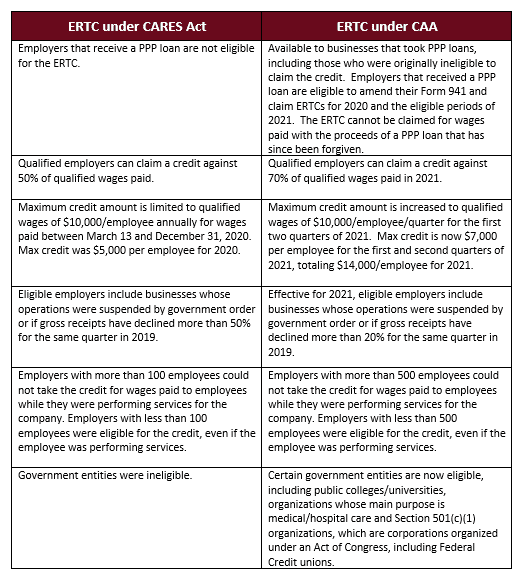Knowledge and Insights
Employee Retention Tax Credit (ERTC) Consolidated Appropriations Act Update

We have received many questions about the updated employee retention credit. This article will take you through the highlights and hopefully answer some of the questions we’ve gotten on this subject. The Consolidated Appropriations Act, (CAA) enacted on December 27, 2020, changed several provisions, involving the employee retention tax credits first implemented under the CARES Act. The most notable change is that the tax credit is now available to businesses that took a loan under the Paycheck Protection Program (PPP). Eligible employers now have until June 30, 2021 to claim the tax credit on qualified wages paid to employees. A credit can only be taken on wages that were not paid with funds forgiven, or expected to be forgiven, under the PPP. This means that if you took a loan and intend to also take the credit, you should prepare your own audit trail to prove that you did not use PPP loan proceeds to pay the wages that you intend to take a tax credit on.
The new legislation allows employers to claim a refundable tax credit against their employer share of Social Security tax equal to 70% of qualified wages paid to employees between January 1 – June 30, 2021. Qualified wages are limited to $10,000 per employee per quarter in 2021 (previously $10,000 per employee per year). Eligible employers can also request advance payment of the credit (using Form 7200) for any 2021 calendar quarter by estimating qualified wages using average quarterly wages from 2019. If the amount of the advance is greater than the actual credit allowed, the excess will need to be repaid.
Beginning in 2021, a qualified employer will be considered “small” if it is a company with no more than 500 employees. In 2020, under the CARES Act, a small employer was considered to have no more than 100 employees. An employer with less than 500 employees can use all qualified wages paid to employees rather than determining the compensation paid to employees for time they were not working, either due to government orders or a reduction in gross receipts. This increase in the number of employees will allow more companies to count all wages paid during their qualified period, simplifying the process, resulting in larger credits. If an employer has more than 500 employees, the company can only use this credit on the qualified wages for employees who are not working.
Under the CAA, the gross receipts test changed, so that a company whose gross receipts have had a decline greater than 20% in 2021, compared to the same quarter in 2019, satisfies the test. Companies can also elect to use the gross receipts from the immediately preceding quarter and compare these preceding quarter gross receipts to the same quarter of 2019. For new companies that did not exist in 2019, they may use the corresponding quarter in 2020 for the gross receipts test. Employers can file an amended Form 941 if they determined that they qualified for the credit in 2020.
The CAA clarified questions about employee benefit costs for furloughed employees. For a furloughed employee where the employer continued to pay pre-tax health benefits, these amounts can be counted as qualified health expenses for the ERTC calculation. Additionally, the CAA language supports the IRS using the section 6033 definition of gross receipts for tax exempt organizations. This definition includes total sales, amounts received for services and income from investments.
Below is a comparison of the changes between the ERTC implemented under the CARES Act and the changes under the CAA:

As guidance continues to be issued on the employee retention tax credit, our COVID Consulting Team will continue to be a resource for any questions relating to the ERTC, in addition to providing assistance with other provisions under the CARES Act and the CAA. If you have any questions relating to the ERTC, please feel free to contact me at ckolczynski@mercadien.com or 609-689-9700.
DISCLAIMER: This advisory resource is for general information purposes only. It does not constitute business or tax advice and may not be used and relied upon as a substitute for business or tax advice regarding a specific issue or problem. Advice should be obtained from a qualified accountant, tax practitioner or attorney licensed to practice in the jurisdiction where that advice is sought.
